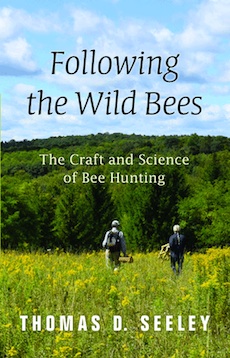By Germaine Cornelissen-Guillaume
This is a refreshing little book smartly organized to appeal to nature lovers interested in an old-time outdoor activity and to the scientist curious about a pollinator now facing increasing threats from emerging new infectious diseases carried by the Varroa mites. Detailed instructions are provided to establish a beeline, estimate the distance and direction of the hive from a starting point, to move down the beeline to get closer to the hive, and to finally find the host tree. Tools to attract foraging bees, capture them, and lure them with anise-scented sugar syrup, mark them with paint for identification, and release them to be able to track them to their hive as the bees make back and forth trips to feed more on the sugar syrup – all are described at great length and in great detail.
At the end of each chapter, Biology Boxes provide compact lessons about honey bees’ lives, covering such topics as: the abundance of colonies in the wild, how foragers and food storers coordinate efforts to make honey, how forager bees communicate by performing the waggle or tremble dance to relate information to other bees about the distance and direction to a rich food source, how fast honey bees fly to and from the hive, how they can find their way, and how they find a suitable habitat.
Thomas D. Seeley (ФВК, Dartmouth College, 1974), an authority on Apis mellifera, skillfully avoids providing a mere guide for bee hunting by interspersing instruction materials with photographs and stories of his own experiences searching for colonies of wild bees, mostly in the forests of upstate New York. He also offers a short historical background about bee hunting, including the differences between natural hives in the wild and managed colonies of movable-frame hives aggregated in modern apiaries.
In the author’s view – and this is how it should be for anyone interested in bee hunting – the real reward of bee hunting is finding the colony’s hiding place, and thus learning more about the behavior of these industrious creatures along the way. The last chapter addresses the important issue of respecting nature by not removing a bee tree. The reader is also reminded of how valuable wild colonies of honey bees are as a genetic resource as the species adapts to threats of disease through relentless selection for resistance to the ectoparasitic mite, Varroa destructor, and the viruses that it transmits. In his recent PLOS ONE paper, Seeley posits that the smaller nest cavities and more frequent swarming of wild colonies contribute to their persistence without mite treatments, as his study shows that colonies in small hives swarm more often, have lower Varroa infestation rates, and higher survival compared to colonies in large hives. A lesson for modern apiaries?
Germaine Cornelissen-Guillaume is a professor of integrative biology and physiology and director of the Halberg Chronobiology Center at the University of Minnesota, Twin Cities.




